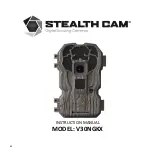
Page 7
5.
Miscellaneous
5.1
Use of Batteries
The camera can be powered by batteries if you wish, and requires a 6V sup-
ply, which can be connected through the Battery Snap.
5.2
Camera Housing and Lighting System
The camera housing contains a light sensor and a powerful array of infra red
lights. If the light level available to the camera drops to a level at which it
requires extra illumination, the infra red lights will automatically switch on.
The infra red lights will enable the camera to give a good picture in dark con-
ditions (with most people’s eyesight, they will be able to see a dim reddish
glow), up to about 5 metres away from the camera. However, if the camera is
used to watch something close in the dark, the infra red may be so bright as to
dazzle part of the camera’s field of view, despite the exposure adjustments
which will be made automatically by the camera’s electronics. If this occurs,
cover part of the array of infra red lights with dark insulating tape (not sup-
plied).
The camera focus has been adjusted at the factory, and cannot be reset by the
user. It will give sharp focus between about 20 cm and infinity.
The camera housing is weatherproof, and designed to be used either in the
open air or inside. Whilst it will withstand rain, do not immerse it in water.
It is important to avoid scratching the glass front to the camera housing, as
this may reduce the quality of the picture. From time to time, we suggest you
clean the glass with a soft cloth.
The direction the camera is pointing is intended to be adjusted using the
bracket. Try to set up the angle of the camera and the position of the sliding
metal shade to avoid the sun shining directly into the lens and to give some
protection from rain falling on the front glass cover.
Page 5






























